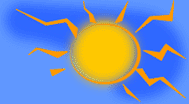|
 |
|||||||
|
The formation of coral islands was a topic of considerable scientific argument in the 19th century. The question that particularly
bothered scientists was this: since corals grow only at shallow depths in the sea (rarely below 80 metres), how is it that
coral rock, formed from their remains, often extends for hundreds of metres beneath the sea? In 1842 the famous scientist Charles Darwin, who visited the Pacific in 1835-6, put forward the theory that coral islands
had been built on slowly subsiding volcanic rocks. As the volcanic foundation sank, it carried the dead coral down to greater
depths. Meanwhile, new deposits of coral were being added to the top of the pile, near the surface, so that the upward growth
of the coral kept pace with the subsidence. At some later date another volcanic movement occurred, and pushed some of the
coral up to form islands. Thus it was, said Darwin that a solid mass of coral rock could be found above the surface of the
sea, and extend from there, through the waters in which it had been formed down to depths at which the coral had never lived. After many years of discussion on the structures of atolls, the Royal Society of London decided to bore down into the coral
and obtain a sample of it from far beneath the surface to see if these samples would contain traces of shallow water organisms.
In 1896 an expedition was sent to Tuvalu (Funafuti) which managed to bore to a depth of 33 metres. In 1897 another party of
scientists led by Professor Edgeworth David of the University of Sydney carried the boring to a depth of 200 metres while
the following year a third group managed to obtain a sample from a depth of 340 metres. All the samples obtained were found
to contain traces of shallow water organisms, but the drilling was never able to reach the volcanic base of Funafuti. Another
attempt was made in 1911, which was also unsuccessful. The boreholes can still be seen to this day, at the site now called
David's Drill. Mrs. David, the wife of Professor Edgeworth David wrote a book describing her experiences in Funafuti. It was published
in 1899 and called Funafuti, Or Three Months on a Coral Island.
|
||||||||
|
Enter content here |
||||||||
 |
||||||||
|
Enter supporting content here |
||||||||